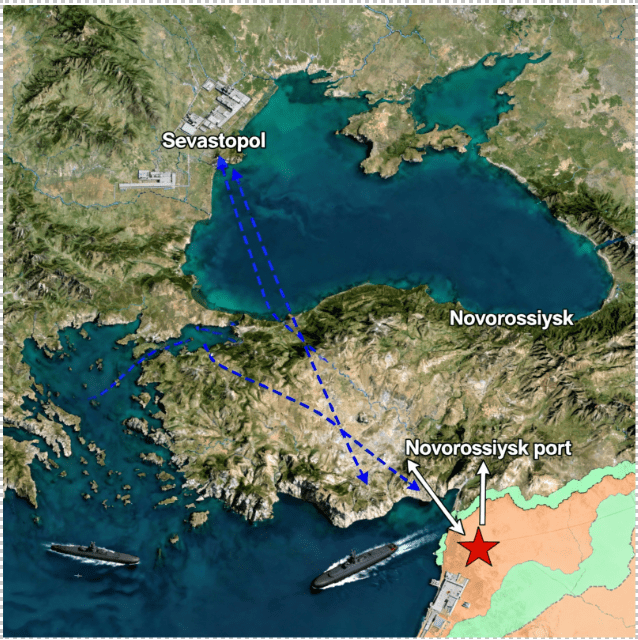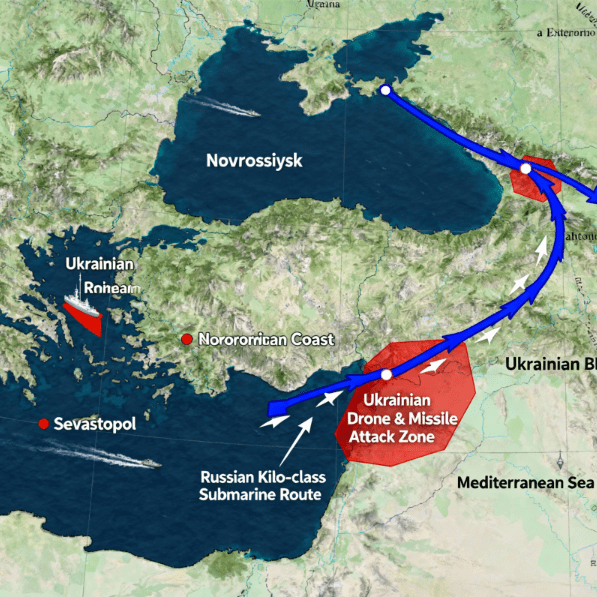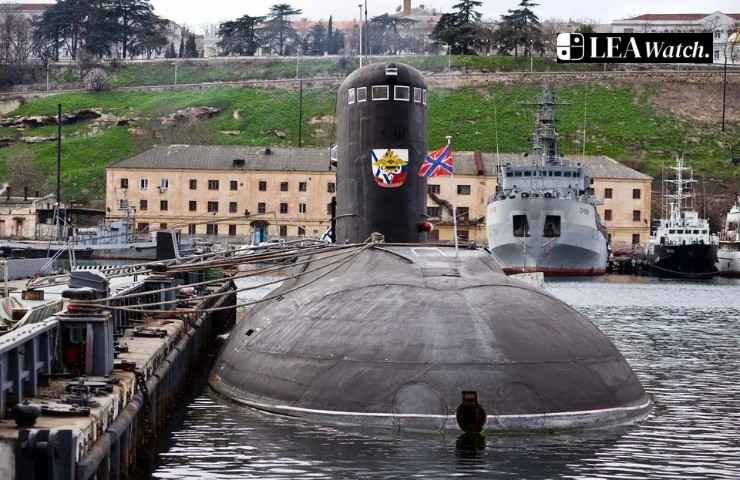A fascinating incident unfolded at sea in October 2025 that was a lot more than mechanical failure, it highlighted changes in the undersea power balance between Russia and NATO. When NATO Secretary-General Mark Rutte described Russian submarine as a submarine “limping home”, he was not just ridiculing Russian weakness; he was trying to signal maneuver above and establish a strategic posture below the surface.
The incident Signal
On October 9, 2025, imagery released by NATO maritime command disclosed the Russian submarine Novorossiysk (B-261) surfacing off the coast of Brittany in France. The Project 636.3 “Improved Kilo II-class” diesel-electric attack submarine came from the Russian Black Sea Fleet, so her surfacing was not a normal behaviour for a vessel expected to travel submerged. The Dutch Navy stated that the submarine was being escorted by the tugboat Yakov Grebelsky through the North Sea, and that they were watching her transit carefully with authorities from the Dutch government. While Moscow denied there was any incident, saying this was a normal surfacing according to navigation rules due to a routine inter-fleet transfer, independent reports published by VChK-OGPU were asserting that the submarine was leaking fuel from the hold on departure, had no spare parts, and a danger of an explosion. This presented NATO Secretary-General Mark Rutte the opportunity to mock the incident, stating it was proof that “there is hardly any Russian naval presence in the Mediterranean left,” and referred to the Novorossiysk as “a lone and broken submarine limping home from patrol” with this comment it revealed both operational pressure and the changing narrative of maritime power.
Technical Profile & Strategic Role of Novorossiysk
The Novorossiysk (B-261) is part of the Improved Kilo II (Project 636.3)-class submarine in Russia’s undersea fleet. The submarine weighs 2,350 tons on the surface and 3,100 tons submerged, measures 74 meters long, and has a beam of 9.9 meters, can operate underwater at speeds of 20 knots (17 knots on the surface), can conduct missions for up to 45 days, and can work at depths of approximately 300 meters. The Novorossiysk is armed with six 533 mm torpedo launchers, allowing it to use torpedoes, mines, and undersea cruise missiles up to four Kalibr cruise missiles for both defensive and offensive operations. The Novorossiysk has been an important submarine in Russia’s Mediterranean Task Force including construct support for the war in Syria, projecting naval power beyond the Black Sea. However, with the increasing drone and missile attacks launched by Ukraine against especially Sevastopol port, Russia has repositioned numerous naval vessels including submarines such as the Novorossiysk to Novorossiysk port, which demonstrates how the changing environment for security is causing strategic shifts redeploying its undersea fleet.

 The Strain Beneath Russia’s Surface
The Strain Beneath Russia’s Surface
The Novorossiysk situation highlights changes in undersea power relationships between Russia and NATO. The image of a submarine that had to transit on the surface apologies for towing implies operational challenge, since it suggests either decline in maintenance capacity, supply shortage in spare parts or logistic vulnerabilities, likely exacerbated by the Ukraine war and western sanctions. The public mockery and exposure by NATO are offensive perception warfare to portray an image of confidence and raise the profile of Russian vulnerability to influence the narrative of maritime superiority. Tactically the incident illustrates a concentric decline of Russian capability in the Mediterranean Sea, especially when considering that their naval presence has declined as operation of the Black Sea Fleet has become significantly constrained and Ukraine is in active conflict over routes into the sea. While NATO has clearly and significantly ramped up its ability to detect and track Russian submarines – as in this case – we have seen cooperative operations in the open from US and partner countries, such as France, Belgium, the Netherlands and UK. It is becoming exceedingly difficult for Russian submarines to operate undetected in waters where there is significant naval activity. The episode also connects to important new security regarding subsea infrastructure, which is an emerging NATO priority in connection with Russian hybrid threat capabilities. With shallow seas in Europe such as the Baltic (52 m average depth) and the North Sea (95 m average depth), pipelines and cables are increasingly vulnerable. In response to this, NATO has bolstered its Maritime Centre for Underwater Infrastructure Security to provide some counter to growing sabotage and intrusion risks against subsea infrastructure. The above two developments collectively indicate a strategic reorientation of capability into the undersea environment, where stealth and power projection has an increasing tilt for NATO.
Although NATO’s narrative around the Novorossiysk incident seems to further enhance the image of a flailing Russian fleet, there are caveats and counter-narratives that mitigate that interpretation. For example, Moscow contends that the submarine surfaced in accordance with transit protocols in the English Channel and museum events were a routine transfer between fleets and not a distress condition. The Novorossiysk is merely one ship that is part of Russia’s overall submarine fleet–which still includes Yasen-class nuclear submarines, such as Arkhangelsk (entered into service in 2024), which have stealth, endurance, and precision strikes at deep sea. Analysts also suggest that these events are politically manipulated: Russia typically wishes to maintain operational failures to keep morale and deterrence high, while NATO can utilize the optics of revealing Russian weakness to promote alliance cohesion. Ultimately, the event is likely to tell us as much about the war as it is to tell us about underwater capacity.
Escalation in Undersea Surveillance and ASW Activity
Several strategic implications follow the Novorossiysk episode, which bears actional concern. If additional Russian submarines are monitored transiting surfaced or under escort, it may indicate a systematic degradation of Russia’s undersea fleet rather than a simple one-off malfunction – particularly as a significant percentage of Russia’s conventional submarines (nearly 40 percent) are Kilo-class submarines commissioned before 2010. Many Kilo-class submarines also face maintenance delays due to sanctions on marine-grade electronics and propulsion systems also play into any potential failure. For NATO, the incident only underscores the requirement to deepen investment in various forms of anti-submarine warfare (ASW), including advanced underwater sensors, autonomous surveillance drones, and integrated domain awareness systems across the North Atlantic and European littorals, particularly given ASW patrols have increased by over 30 to 35 percent since 2022. At the same time, the threat landscape continues to expand: the hybrid operation targeting undersea infrastructure, including data cables, gas pipelines, and communication lines that account for over 97% of global internet traffic will only grow in relevance – especially in Europe’s associated shallow seas in the Baltic and North Sea. And, similar manifestations of Russian at-sea vulnerability could further undermine Moscow’s naval credibility leading to the redefinition of power gaps perceptions in undersea theaters that once defined Russia’s strategic advantage through stealth and deterrence.
The Novorossiysk incident represents something more than an embarrassing moment in time; it marks a new inflection point in the global balance of undersea power. Historically, undersea was largely a realm of secrecy and deterrence, but now the battlespace is increasingly being conceptualized as a context of psychological, informational, and technological warfare. To Russia, a surfacing submarine symbolizes pressure from sanctions, logistical burdens, and expansive preposterous strategy. To NATO, the surfacing validated a developing surveillance network and re-invigorated anti-submarine-warfare (ASW) capabilities, framing a renewed assessment of critical chokepoints. In the end, this incident suggests the next phase of maritime race will not just be conflict in the deep sea, but be a battle for who controls the narrative – and the signal – beneath the deep sea.

